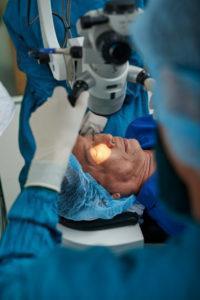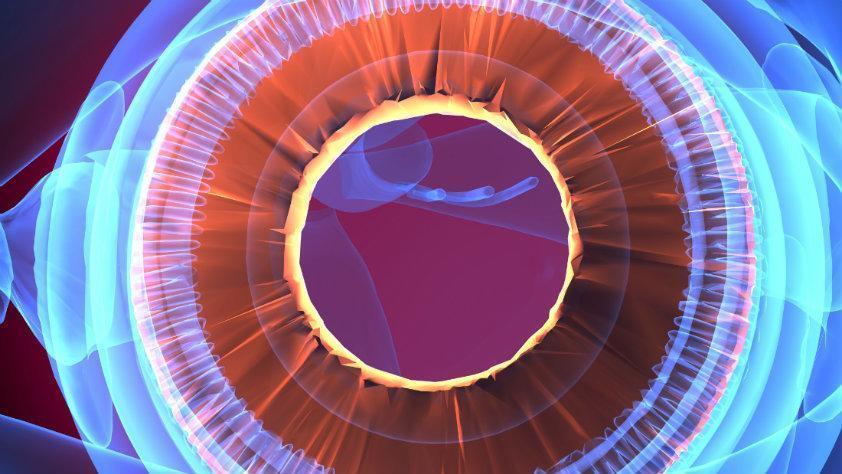Cloudy Vision After Surgery May be a “Secondary Cataract”
Although cataracts cannot return once they are removed, it is possible to develop posterior capsular opacification (PCO), otherwise known as “secondary cataract” or “after-cataract.” There is no way to predict exactly which patients will develop PCO, but it is one of the most common complications of cataract surgery (up to 50 percent per the American Optometric Association).
Although some people may notice cloudiness weeks or months after cataract surgery, it usually takes several years for capsular opacification to develop. The good news is that a quick laser procedure can fix this problem so you can get back to enjoying restored vision.
What is a Secondary Cataract?
During cataract surgery, a circular opening is made in the front portion of the clear membrane that surrounds the cataract. The cataract is then broken up, removed and replaced with a clear intraocular lens (IOL). The new IOL is surrounded by the clear membrane of the eye and, over time, cellular material can migrate to the back portion of the membrane (posterior capsule). As these cells build up and become opaque, the light entering the eye is obscured and scattered, resulting in blurry vision reminiscent of the cataract that was removed.
Secondary Cataract Symptoms
The term “secondary cataract” is a misnomer, since it’s not actually another cataract distorting your vision. It is easy to understand why people use this term instead of posterior capsular opacification, as its symptoms match cataract line for line:
- Cloudy, milky, or hazy vision
- Decreased vision and difficulty seeing at night
- Glare caused by bright lights
- Double vision
Laser Treatment for Secondary Cataracts

Treatment for a secondary cataract is simple. It involves a technique called YAG laser capsulotomy, a non-invasive outpatient procedure that only takes a few minutes to perform and can result in almost immediate vision improvement. There is no incision or contact with the eye during the procedure, which means no pain or discomfort.
During a YAG laser capsulotomy, the ophthalmologist uses short pulses of laser energy to make a small hole in the posterior capsule. This opening eliminates cloudy vision by allowing light to pass unobstructed to the back of the eye, whereas before it was being obscured and scattered.
Although the results are often immediate, your vision may still be a little blurry after the procedure from dilation of the pupil and debris from the capsule that was broken up. In most cases, you will have a follow-up appointment a week or so later to check the pressure of the eye and see how much the vision has improved.
YAG Laser Capsulotomy Complications
As with any ocular procedure, there are potential complications patients should be aware of when considering YAG laser capsulotomy to remove a secondary cataract. The most common is increased intraocular pressure (IOP). However, most patients with increased IOP return to normal within 24 hours after the procedure due to the laser energy quickly dissipating from the eye. Patients with glaucoma or other vision-threatening eye diseases are more likely to experience IOP spikes and will need to be monitored more closely during the postoperative period.
The second most common complication associated with YAG laser capsulotomy is anterior uveitis (inflammation inside the eye), although it is incredibly rare for patients to develop any clinically significant eye pain or discomfort. Most patients do not need treatment after a YAG capsulotomy, but postoperative inflammation can be managed with anti-inflammatory eye drops.
A more serious but rare complication that can occur is a retinal tear or detachment when the retina pulls away from the supportive tissues within the eye. Other causes of retinal detachment include injury, advanced diabetes, and age-related retinal disorders. If you notice these symptoms of retinal detachment, for any reason, contact an eye doctor immediately:
- Sudden appearance of “floaters” (tiny specks that seem to float through your field of vision)
- Gradual peripheral vision loss
- Sudden flashes of light in one or both eyes
- A curtain-like shadow over your visual field
Alternative Treatment for Posterior Capsular Opacification
The only alternative to YAG capsulotomy for the treatment of a secondary cataract is to do nothing. The capsule may continue to thicken and become opaquer over time, or it may remain at the current level. In any case, the decision to have this procedure is based on the same criteria as the decision to have cataract surgery in the first place, such as weighing the cost of the procedure against the benefit of seeing clearly. YAG laser capsulotomy is not needed unless vision loss or distortion is affecting your lifestyle.
Talk to an Eye Doctor About Secondary Cataracts
If you are experiencing cloudy vision months or even years after cataract surgery, contact the eye doctors at Southwestern Eye Center. Our ophthalmologists will determine if a posterior capsular opacification is the culprit, and then discuss options for restoring your vision. And if you’re considering cataract surgery in your other eye, Southwestern Eye Center brings the latest advancements for better outcomes after surgery.
Contact an eye doctor online or call (480) 854-8185.
